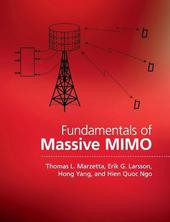
|
Fundamentals of Massive MIMO
Hardback
Main Details
Description
Written by pioneers of the concept, this is the first complete guide to the physical and engineering principles of Massive MIMO. Assuming only a basic background in communications and statistical signal processing, it will guide readers through key topics in multi-cell systems such as propagation modeling, multiplexing and de-multiplexing, channel estimation, power control, and performance evaluation. The authors' unique capacity-bounding approach will enable readers to carry out effective system performance analyses and develop advanced Massive MIMO techniques and algorithms. Numerous case studies, as well as problem sets and solutions accompanying the book online, will help readers put knowledge into practice and acquire the skill set needed to design and analyze complex wireless communication systems. Whether you are a graduate student, researcher, or industry professional working in the field of wireless communications, this will be an indispensable guide for years to come.
Author Biography
Thomas L. Marzetta is the originator of Massive MIMO. He is a Bell Labs Fellow at Nokia and a Fellow of the IEEE, and previously worked at Schlumberger-Doll Research and Nichols Research Corporation. He has received numerous recognitions and awards, including the IEEE W. R. G. Baker Award (2015), the IEEE Communications Society Stephen O. Rice Prize (2015), and the IEEE Guglielmo Marconi Prize Paper Award (2013). He is the recipient of an Honorary Doctorate from Linkoeping University, Sweden. Erik G. Larsson is a Professor at Linkoeping University, Sweden and a Fellow of the IEEE. He is the co-author of 120 journal papers and the textbook Space-Time Block Coding for Wireless Communications (Cambridge, 2003). He currently serves as Chair of the IEEE SPS Technical Committee for Signal Processing for Communications and Networking (2015-2016). In both 2012 and 2014, he received the IEEE Signal Processing Magazine Best Column Award, and in 2015 he was awarded the IEEE Communications Society Stephen O. Rice Prize. Hong Yang is a member of technical staff at Nokia Bell Labs' Mathematics of Networks and Communications Research Department, where he conducts research into wireless communications networks. He has over fifteen years of industrial research and development experience, and has previously worked in both the Department of Radio Frequency Technology Systems Engineering and the Wireless Design Center at Alcatel-Lucent. Hien Quoc Ngo is a researcher at Linkoeping University, Sweden. In 2015, he received the IEEE Communications Society Stephen O. Rice Prize and the IEEE Sweden VT-COM-IT Joint Chapter Best Student Journal Paper Award. He was also an IEEE Communications Letters exemplary reviewer in 2014 and an IEEE Transactions on Communications exemplary reviewer in 2015.
Reviews'Massive MIMO has, over the past few years, become one of the hottest research topics in wireless, and will be a key component of 5G. This book is written by pioneers of the area in a systematic and lucid way, and works out the fundamentals without getting lost in the details. I highly recommend it to anybody working in this field.' Andreas Molisch, University of Southern California, Los Angeles 'Bright and profound, this book provides the fundamentals to understand the unique capabilities of Massive MIMO and illustrates the benefits for specific use cases. The authors are scientific pioneers and masters in explaining and sharing their proficiency in this book: it is an intellectual treat for everyone fascinated by Massive MIMO technology!' Liesbet van der Perre, Katholieke Universiteit Leuven, Belgium 'A very timely text by some of the 'founding fathers' of massive MIMO. This is a great book for both the beginner, with its simple but enlightening examples, as well as a great reference text for the more experienced engineer. The book is concise and to the point, and the summary and key points at the end of each chapter make it easy to focus your reading. Highly recommended for those that want to get an in-depth understanding of massive MIMO without spending months doing so.' Lee Swindlehurst, University of California, Irvine 'The book Fundamentals of Massive MIMO elegantly combines the basic principles of large multi-user MIMO wireless systems with practical case studies, which makes it useful for both researchers and practitioners. The fact that the book is fully self-contained also makes it an excellent teaching resource. There is no doubt that it will become the standard reference on massive MIMO.' Christoph Studer, Cornell University 'Massive MIMO will dramatically change the way we use multiple antenna technologies in next generation mobile wireless cellular systems, offering new potential for effective interference mitigation while maximizing spectral efficiency; this book, written by a group of experts in the field including the inventor of this new and exciting technology himself, will prove to be an invaluable reference for every wireless communications engineer.' Stephan ten Brink, University of Stuttgart, Germany 'This is an excellent book on a very timely topic, written by some of the top researchers in the area of massive MIMO. I would encourage researchers, students and practicing engineers to consult this book.' Rick S. Blum, Lehigh University, Pennsylvania
|